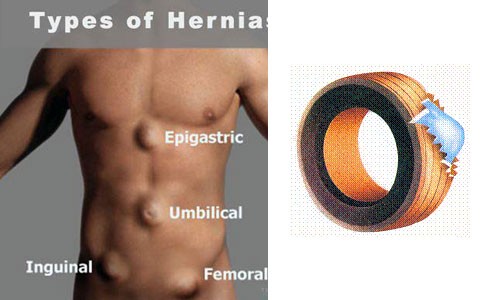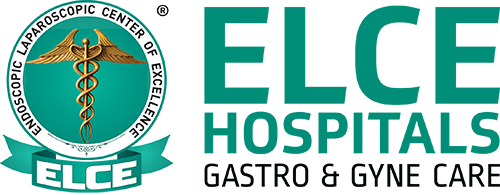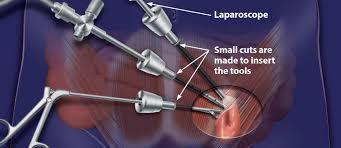Hernia Treatment
HERNIA – SYMPTOMS AND TREATMENT
Know About
What is Hernia?

A hernia is a protrusion of viscus through a defect in the tissues (muscles) surroundings that covers it. A hernia simply means that your muscles-fascia system develops a defect and any intra- abdominal content starts coming out of the defect (like bowel and omentum) . There are several locations where hernia may occur like upper abdomen(epigastric), central (umbilical), over a scar site (incisional), inguinal etc. This article explains the symptoms and surgery for hernia .
Types of Hernia
INGUINAL HERNIAS
Inguinal hernias an Inguinal hernia is a bulging of the contents of the abdomen through a weak area in the muscles in the lower abdominal wall. Inguinal hernias occurs through the defect and reaches the groin via a passage called inguinal canals.
Inguinal hernias typically develop on one side of the groin and form on the right side more often than on the left.Inguinal hernias may slide in and out of the abdominal wall.Inguinal hernias most often contain fat (omentum) or sometimes part of small intestine.

Femoral Hernia: Inguinal hernias can also occur through two deeper passages in the groin called the femoral canals. Hernias through these passages are also known as femoral hernias.
Para- umbilical Hernia : Hernia can occur sometimes through a weakness over umbilical region and is called a Para- umbilical hernia .This mostly contains fat but rarely small intestine can also be part of contents. ELCE hospitals is the leading inguinal hernia treatment hospital in Coimbatore has experience doctors in treating hernia surgery for years.
Risk Factors of Hernia Surgery :
Most of the hernias do not have any specific cause factor (idiopathic)
Some of the causes considered to influence the formation of a hernia are –
- genetic predisposition(congenital defect)
- chronic cough – in patients of bronchial asthma, COPD
- premature birth
- previous major surgeries
- chronic constipation
- male gender
- obesity or being overweight
- Occupation like lifting heavy weights
Symptoms of Hernia:
The presentation of hernia symptoms depends upon the site of occurrence and the size of defect and its contents involved.
Inguinal Hernia -The most noticeable sign of inguinal hernias is a small bulge on one or both sides of the groin. The bulge becomes more prominent on standing and may disappear on lying down. The clinician examines the groin and scrotum to assess the extent and site of inguinal hernia .
- Discomfort over groin(congenital defect)
- Large swelling extending upto scrotum
- Para- umbilical hernia: Symptoms are swelling in umbilical region . Sometimes obstruction leads to pain.
- Complications : of all the above types of hernia occurs when the contents become irreducible.
- Irreducible hernia leading to obstruction , finally Strangulated hernia .
HERNIA TREATMENT – SURGERY :
Treatment for Inguinal Hernia :
Inguinal hernia repair is a common surgical procedure. Inguinal hernia surgery is also called herniorrhaphy or hernioplasty.
Principle of Hernia surgery treatment :
The weak spot in the inguinal region at the anterior abdomen muscle wall is where the bulge occurs-traditionally has been repaired by sewing the edges of healthy muscle tissue together (herniorrhaphy).
This repair alone is enough for smaller hernias that occur in children –paediatric inguinal hernias.
Synthetic Mesh repair patches :
Synthetic Mesh repair patches are now being widely used to repair hernias (hernioplasty). This is especially true for large hernias and for hernias that reoccur.The Synthetic mesh reinforces the weakened tissues and thus greatly reduces the chance of recurrence.
Surgical repair involves the dissection and careful placement of mesh patch and suturing over weakened area in the abdominal wall after the hernia is pushed back into place. The patch decreases the tension on the weakened belly wall, reducing the risk that a hernia will recur.
LAP INGUINAL HERNIA SURGERY:
ELCE Hospitals – The use of laparoscopic methods for inguinal hernia surgery is advanced minimal invasive surgery with less tissue trauma, less postoperative pain, lower postoperative infection risk and faster postoperative recovery.
Therefore it is now being done as a day care procedure.
There are two main techniques when laparoscopic inguinal hernia repair is concerned. These are defined as transabdominalpreperitoneal approach (TAPP) and total extraperitoneal approach (TEP).
TAPP procedure- In this abdominal approach the peritoneal flap is opened and the hernia sac is separated from cord structures and space is dissected for mesh . A mesh is then introduced and placed over the defect and sutured using prolene sutures .
TEP- This variation is a Total extra –peritoneal approach that avoids entering the abdomen like TAPP procedure. Here ports are placed differently and the surgery is done via the extraperitoneal space and mesh is placed and sutured
Procedure :
- Laparoscopic camera and instruments are introduced via small incisions over the abdomen and thereby enable the surgery to be done via these ports itself .
- Laparoscopic monitors are positioned at the foot of the bed, and the surgeon opposite the side of the the hernia to be worked on
- An incision is used to access the peritoneal cavity and totally three ports are placed . The lap camera is introduced and visualises the site of surgery. Two other ports are introduced in separate incisions and are used for instruments.
- The peritoneal flap is opened and the hernia sac is separated from cord structures and space is dissected for mesh .Special polypropelene mesh is placed to cover the defect and sutured in place .

Complications :
Complications are relatively rare with newer modalities of surgery .Rarely nerve damage leading to inguinal pain, infection or recurrence of hernia has been noted.
Advantages of Hernia Treatment:
- Less tissue trauma.
- Smooth recovery during post-op period enables it as day care procedure.
- Less pain , less chance of external infections .
- Faster post-op recovery.
Recent Advances :
Robotic Hernia surgery– This involves use of robotic lap instruments and enables very fine dissection and provides superior view and superior manipulation of instruments via robotic arms. This is an emerging technology which shall greatly improve patient outcomes.
Conclusion:
Inguinal Hernia surgery being one of the commonly performed surgeries has undergone rapid changes in the past few decades.After the advent of lap surgery , several technical advances in lap instrumentation and camera visualisation has happened . Now hernia surgery is very much advanced and is being done with minimal pain and superior patient recovery .

